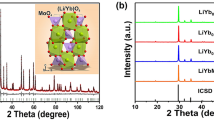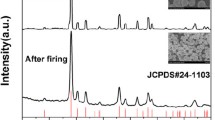Abstract
In this work, Y2O3: Tm3+, Eu3+ phosphors were made by homogeneous precipitation with urea as precipitator. The emission spectra varying with temperature of Y2O3: Tm3+, Eu3+ phosphors were measured and analyzed. Analysis show that the luminescence of Eu3+ represents a normal thermal quenching change, while that of Tm3+ exhibits slow thermal enhancement phenomenon. In the temperature range of 303-503 K, the luminescence of Tm3+ showed a trend of first strengthening and then weakening. The reason for this phenomenon of Tm3+ is that there is energy transfer from Eu3+ to Tm3+, and the energy transfer efficiency increases gradually with temperature. Meanwhile, the luminescence of Tm3+ also have thermal quenching effect. Under the combined influence of thermal quenching and energy transfer, the luminescence of Tm3+ first becomes stronger and then then becomes weaker. According to the calculation, the luminescence intensity ratio (LIR) of Tm3+ and Eu3+ conforms to the linear empirical formula with increasing temperature. The relative sensitivity of phosphors decreases with Eu3+ concentration increased, and the maximum Sr reaches 0.460% K−1 (1% Tm3+, 0.3% Eu3+, at 303 K). Moreover, the temperature cycle test present that the LIR of phosphors has good repeatability.














Similar content being viewed by others
Availability of Data and Materials
Data and materials will be made available on request.
References
Wang Q, Liao M, Lin QM et al (2021) A review on fluorescence intensity ratio thermometer based on rare earth and transition metal ions doped inorganic luminescent materials. J Alloys Compd 850:156744
Wang XF, Liu Q, Bu YY et al (2015) Optical temperature sensing of rare-earth ion doped phosphors. RSC Adv 5:86219–86236
Wang X, Li XP, Xu S et al (2021) Temperature-dependent luminescence properties of Dy3+, Tm3+ single-/co-doped YNbO4 phosphors. Optik 238:166524
Ranjith P, Sreevalsa S, Tyagi J et al (2020) Elucidating the structure and optimising the photoluminescence properties of Sr2Al3O6F: Eu3+ oxyfluorides for cool white LEDs. J Alloy Compd 826:154015
Yang K, Shen Y, He K et al (2021) An optical fiber temperature sensor based on fluorescence intensity ratio used for real-time monitoring of chemical reactions. Ceram Int 47:33537–33543
Pudovkin MS, Ginkel AK, Lukinova EV (2021) Temperature sensitivity of Nd3+, Yb3+:YF3 ratiometric luminescent thermometers at different Yb3+ concentration. Opt Mater 119:111328
Laia AS, Hora DA, Dos SMV et al (2020) Comparing the performance of Nd3+-doped LiBaPO4 phosphors as optical temperature sensors within the first biological window exploiting luminescence intensity ratio and bandwidth methods. J Lumin 227:117524
Piao RQ, Liu DY, Yuan N et al (2018) Multiple ratiometric thermometry using electronic transitions between Stark sublevels of Er3+ for reliable temperature detection. J Alloy Compd 756:201–211
Pudovkin MS, Kuznetsov SV, Proydakova VY et al (2020) Luminescent thermometry based on Ba4Y3F17:Pr3+ and Ba4Y3F17:Pr3+, Yb3+ nanoparticles. Ceram Int 46:11658–11666
Miroslav DD (2020) Trends in luminescence thermometry. J Appl Phys 128:040902
Wang Q, Liao M, Lin QM et al (2021) A review on fluorescence intensity ratio thermometer based on rare-earth and transition metal ions doped inorganic luminescent materials. J Alloy Compd 850:156744
Prashant MK, Avinash RK, Sahare PD et al (2022) Structural, compositional and luminescence studies of Y2O3:Eu3+ nanophosphor synthesized by sol-gel method. J Alloy Compd 928:167106
Julian P, Rajesh K, Christoph G et al (2022) Simple one pot synthesis of luminescent europium doped yttrium oxide Y2O3: Eu nanodiscs for phosphor converted warm white LEDs. Nanoscale Adv 4:858–864
Ma WJ, Li Z, Lu P et al (2022) Multisignal optical temperature-sensing properties of Eu3+-doped NaYF4 nanoparticles. Luminescence 37:2098–2104
Wang JY, Liu XX, Liu Y et al (2018) Luminescence and energy transfer properties of Gd2P4O13:Tm3+, Dy3+ phosphor with UV light excitation. Optik 175:304–311
Wang T, Wang SY, Zhang HB et al (2020) Preparation, luminescence properties and energy transfer of Tm3+ and Tm3+-Eu3+ doped glass-ceramics containing NaY(MoO4)2. J Solid State Chem 284:121184
Ma H, Wang XD, Chen FF et al (2021) Luminescence properties and energy transfer mechanism of Eu3+ and Tm3+ Co-doped AlN thin films. J Lumin 236:118082
Zhou SS, Li XM, Zhang SB (2021) Design of opposite thermal behaviors in Tm3+/Eu3+ co-doped YVO4 for high-sensitivity optical thermometry. Opt Lett 46:1301–1304
Devaraju MK, Yin S, Sato T (2009) Solvothermal synthesis and characterization of blue, green and red emitting Y2O3:Ln3+ (Ln3+= Tm3+, Tb3+ and Eu3+) nanocrystals. MSE 1:012011
Yadav RS, Rai SB (2019) Effect of annealing and excitation wavelength on the downconversion photoluminescence of Sm3+ doped Y2O3 nano-crystalline phosphor. Opt Laser Technol 111:169–175
Delice S, Isik M, Gasanly NM (2019) Low temperature thermoluminescence behaviour of Y2O3 nanoparticles. J Rare Earths 37:19–23
Shivaramu NJ, Lakshminarasappa BN, Coetsee E, Swart SHC (2021) Thermoluminescence behavior of gamma irradiated Y2O3: Sm3+ nanophosphor. J Lumin 232:117855
Piramidowicz R, Jusza A, Lipińska L et al (2020) UV-blue luminescent properties of Tm3+: Y2O3 nanocrystals and PMMA-based composites. J Lumin 226:117458
Zhao QR, Qian BF, Wang YL et al (2022) Facile synthesis of CaO:Eu3+ and comparative study on the luminescence properties of CaO: Eu3+ and CaCO3: Eu3+. J Lumin 241:118491
Janaína Gomes AO (2006) Nanocrystalline RE2O3:Tm3+ (RE: Gd3+, Y3+) Blue Phosphors Synthesized via the Combustion Method. J Fluoresc 16:411–421
Lovisa LX, Silva JMPD, Santiago AAG et al (2022) Red-emitting CaWO4:Eu3+, Tm3+ phosphor for solid-state lighting: Luminescent properties and morphology evolution. J Rare Earth 40:226–233
Huang XM, He C, Zhu X et al (2021) Synthesis and characterization of Eu3+-doped RbCaLa(VO4)2 phosphors and influence of temperature on fluorescence properties. Ceram Int 47:32130–32137
Zhang J, Pei YQ, Ma CL, Zhang YN (2022) The direct identification of quantum cutting in Tm3+ ions and energy transfer in the Tm3+/Yb3+ system based on a Ba2Gd2Si4O13 oxide host†. Inorg Chem Front 9:719–728
Li X, Yang C, Liu QS et al (2020) Enhancement of luminescence properties of SrAl2Si2O8: Eu3+ red phosphor. Ceram Int 46:17376–17382
Liu YJ, Wang RG, Yang QH et al (2022) The tri-emitting phosphate phosphors SrIn2(P2O7)2: Tm, Dy, Eu for ratiometric optical thermometer. J Am Ceram Soc 105:6184–6195
Lisiecki R, Romanowski WR, Lukasiewicz T (2006) Relaxation of excited states of Tm3+ and Tm3+-Eu3+ energy transfer in YVO4 crystal. Appl Phys B 83:255–259
Wang BX, Ren Q, Hai O, Wu XL (2017) Luminescence properties and energy transfer in Tb3+ and Eu3+ co-doped Ba2P2O7 phosphors. RSC Adv 7:15222–15227
Zhang XG, Zhang JL, Chen YB, Gong ML (2016) Energy transfer and multicolor tunable emission in single-phase Tb3+, Eu3+ co-doped Sr3La(PO4)3 phosphors. Ceram Int 42:13919–13924
Liao JS, Kong LY, Wang MH et al (2019) Tunable upconversion luminescence and optical temperature sensing based on non-thermal coupled levels of Lu3NbO7:Yb3+/Ho3+ phosphors. Opt Mater 98:109452
Li L, Tang XH, Wu ZJ et al (2019) Simultaneously tuning emission color and realizing optical thermometry via efficient Tb3+/Eu3+ energy transfer in whitlockite-type phosphate multifunctional phosphors. J Alloy Compd 780:266–275
Wang CL, Jin YH, Zhang RT et al (2022) A review and outlook of ratiometric optical thermometer based on thermally coupled levels and non-thermally coupled levels. J Alloy Compd 894:162494
Gao Y, Huang F, Lin H et al (2016) A novel optical thermometry strategy based on diverse thermal response from two intervalence charge transfer states. Adv Funct Mater 26:3139–3145
Yang YM, Lin L, Lu P et al (2021) A linear calibrated high temperature sensor based on up-conversion fluorescence of Y2Mo3O12:Er3+, Yb3+ enhanced by negative thermal expansion. J Lumin 240:118410
Zhu Y, Meng QY, Sun WJ, Lü SC (2020) NaLa(MoO4)2:Sm3+, Tb3+ phosphor: Optical temperature sensing material with a wide change range of luminescence color. J Lumin 218:116854
Huang F, Chen DQ (2017) Synthesis of Mn2+: Zn2SiO4-Eu3+: Gd2O3 nanocomposites for highly sensitive optical thermometry through the synergistic luminescence from lanthanide-transition metal ions. J Mater Chem C 5:5176–5182
Zhang J, Jiang XM, Hua ZH (2018) Investigation on Upconversion Luminescence and Optical Temperature Sensing Behavior for Ba2Gd2Si4O13:Yb3+-Er3+/Ho3+/Tm3+ Phosphors. Ind Eng Chem Res 57:7507–7515
Hu FF, Zhao ZM, Chi FF et al (2017) Structural characterization and temperature-dependent luminescence of CaF2:Tb3+/Eu3+ glass ceramics. J Rare Earths 35:536–541
Zhang J, Yu HL, Hua ZH et al (2023) Optical temperature-sensing properties in La1.55SiO4.33:Yb3+,Ho3+ phosphors affected by Ho3+-doping concentration. J Lumin 261:19940
Mo FW, Zhang XG, Sun ZS et al (2019) Luminescence of K2BaCa(PO4)2: Ce3+, Tb3+ dual-emitting phosphor and its application as ratiometric optical thermometer. Ceram Int 45:12319–12324
Laia AS, Maciel GS, Rodrigues JJ Jr et al (2022) Lithium-boron-aluminum glasses and glass-ceramics doped with Eu3+: A potential optical thermometer for operation over a wide range of temperatures with uniform sensitivity. J Alloy Compd 907:164402
Funding
This study was supported by the Heilongjiang Province Natural Science Foundation of China (Grant No. LH2022A027).
Author information
Authors and Affiliations
Contributions
Huixin Liu: Experiment, Data curation, Methodology, Writing—original draft. Qingyu Meng: Idea, Resources, Supervision, Writing—review and editing. Changwen Wang: Validation, Investigation, Resources.
Corresponding author
Ethics declarations
Ethical Approval
Not applicable.
Competing Interests
The authors declare no competing interests.
Additional information
Publisher's Note
Springer Nature remains neutral with regard to jurisdictional claims in published maps and institutional affiliations.
Rights and permissions
Springer Nature or its licensor (e.g. a society or other partner) holds exclusive rights to this article under a publishing agreement with the author(s) or other rightsholder(s); author self-archiving of the accepted manuscript version of this article is solely governed by the terms of such publishing agreement and applicable law.
About this article
Cite this article
Liu, H., Meng, Q. & Wang, C. Optical Temperature Sensing Based on Linear Change of Luminescence Intensity Ratio in Y2O3: Tm3+, Eu3+ Phosphors. J Fluoresc (2023). https://doi.org/10.1007/s10895-023-03516-5
Received:
Accepted:
Published:
DOI: https://doi.org/10.1007/s10895-023-03516-5




